Komeito, formerly called New Komeito, is a political party in Japan founded by members of the Nichiren Buddhist-based new religious movement Soka Gakkai. The party is sometimes called by its former name, Clean Government Party.

The Liberal Democratic Party of Japan, frequently abbreviated to LDP or Jimintō (自民党), is a conservative political party in Japan.

The Taishō period, or Taishō era, is a period in the history of Japan dating from 30 July 1912, to 25 December 1926, coinciding with the reign of the Emperor Taishō. The new emperor was a sickly man, which prompted the shift in political power from the old oligarchic group of elder statesmen to the Imperial Diet of Japan and the democratic parties. Thus, the era is considered the time of the liberal movement known as the "Taishō democracy" in Japan; it is usually distinguished from the preceding chaotic Meiji period and the following militaristic-driven first part of the Shōwa period.
This article gives an overview of liberalism in Japan. It is limited to liberal parties with substantial support, proved by having had representation in parliament. The sign ⇒ means a reference to another party in that scheme. For inclusion in this scheme it isn't necessary that parties labelled themselves `liberal`.
The National Labor Party was formed by Australian Prime Minister Billy Hughes in 1916 following the 1916 Labor split on the issue of World War I conscription in Australia. Hughes had taken over as leader of the Australian Labor Party and Prime Minister of Australia when anti-conscriptionist Andrew Fisher resigned in 1915. He formed the new party for himself and his followers after he was expelled from the ALP a month after the 1916 plebiscite on conscription in Australia. Hughes held a pro-conscription stance in relation to World War I.

Elections to the United States House of Representatives in 1916 were held for members of the 65th Congress, coinciding with the re-election of President Woodrow Wilson.
Political parties appeared in Japan after the Meiji Restoration, and gradually increased in importance after the promulgation of the Meiji Constitution and the creation of the Diet of Japan. During the Taishō period, parliamentary democracy based on party politics temporarily succeeded in Japan, but in the 1930s the political parties were eclipsed by the military, and were dissolved in the 1940s during World War II

Japan participated in World War I from 1914 to 1918 in an alliance with Entente Powers and played an important role in securing the sea lanes in the West Pacific and Indian Oceans against the Imperial German Navy as the member of the Allies. Politically, the Japanese Empire seized the opportunity to expand its sphere of influence in China, and to gain recognition as a great power in postwar geopolitics.
The Liberal Reform Party was an Australian political party, active in New South Wales state politics between 1901 and 1916. It drew much of its support from Protestant and Temperance groups.
Farmers' Party may refer to:

The Rikken-Dōshi Kai was a political party active in the Empire of Japan in the early years of the 20th century. It was also known as simply the Dōshikai.

The Kenseikai was a short-lived political party in the pre-war Empire of Japan.

The 1916 Republican National Convention was held in Chicago from June 7 to June 10. A major goal of the party's bosses at the convention was to heal the bitter split within the party that had occurred in the 1912 presidential campaign. In that year, Theodore Roosevelt bolted the GOP and formed his own political party, the Progressive Party, which contained most of the GOP's liberals. William Howard Taft, the incumbent president, won the nomination of the regular Republican Party. This split in the GOP ranks divided the Republican vote and led to the election of Democrat Woodrow Wilson. Although several candidates were openly competing for the 1916 nomination—most prominently conservative Senator Elihu Root of New York, Senator John W. Weeks of Massachusetts, and liberal Senator Albert Cummins of Iowa—the party's bosses wanted a moderate who would be acceptable to all factions of the party. They turned to Supreme Court Justice Charles Evans Hughes, who had served on the court since 1910 and thus had the advantage of not having publicly spoken about political issues in six years. Although he had not sought the nomination, Hughes made it known that he would not turn it down; he won the nomination on the third ballot. Former Vice-President Charles W. Fairbanks was nominated as his running mate. Hughes was the only Supreme Court Justice to be nominated for president by a major political party. Fairbanks was the last former vice president, to be nominated for vice president.

The Nacionalista Party is the oldest political party in the Philippines and in Southeast Asia responsible for leading the country throughout the majority of the 20th century since its founding in 1907, being the ruling party from 1935 to 1944, 1944–1946, 1953–1957, 1957–1961 and 1965–1972.

The 1916 Democratic National Convention was held at the St. Louis Coliseum in St. Louis, Missouri from June 14 to June 16, 1916. It resulted in the nomination of President Woodrow Wilson and Vice President Thomas R. Marshall for reelection.

The United States House of Representatives elections in California, 1916 was an election for California's delegation to the United States House of Representatives, which occurred as part of the general election of the House of Representatives on November 7, 1916. The delegation's only Independent incumbent retired and the open seat was won by the Democrats.
The Kōseikai was a short-lived political party in Japan.
The Kōyū Club was a political party in Japan.











